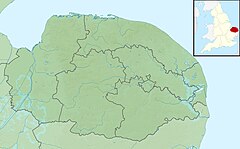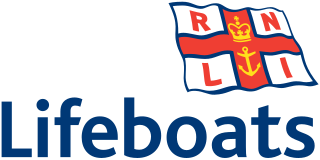
The Royal National Lifeboat Institution (RNLI) is the largest of the lifeboat services operating around the coasts of the United Kingdom, the Republic of Ireland, the Channel Islands, and the Isle of Man, as well as on some inland waterways.
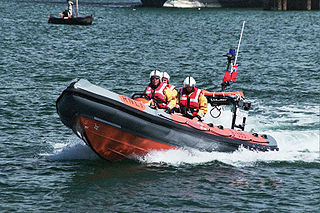
A rigid inflatable boat (RIB), also rigid-hull inflatable boat or rigid-hulled inflatable boat (RHIB), is a lightweight but high-performance and high-capacity boat constructed with a rigid hull bottom joined to side-forming air tubes that are inflated with air to a high pressure so as to give the sides resilient rigidity along the boat's topsides. The design is stable, light, fast and seaworthy. The inflated collar acts as a life jacket, ensuring that the vessel retains its buoyancy, even if the boat is taking on water. The RIB is an evolutionary development of the inflatable boat with a rubberized fabric bottom that is stiffened with flat boards within the collar to form the deck or floor of the boat.

The D-class (EA16) lifeboat is a class of inflatable boat operated since 1987 by the Royal National Lifeboat Institution of the United Kingdom and Ireland. It has been replaced operationally by the D-class (IB1), but many are still used as part of the relief fleet, as boarding boats for the larger classes of lifeboat and by the RNLI Flood Rescue Team.

The D-class (IB1) lifeboats are inflatable boats serving in the RNLI inshore lifeboat (ILB) fleet as well as a number of Independent Lifeboats around the UK and Ireland. Although they are known as the "IB1" at times, they are the latest development of the D-class lifeboat and as such are mainly referred to as a "D-class".
Since its inception, the Royal National Lifeboat Institution (RNLI) has provided lifeboats to lifeboat stations in the United Kingdom and Ireland.

The Arancia-class inshore rescue craft is a class of small inflatable rescue boat (IRB) operated by, among others, Surf Lifesaving Great Britain, Surf Life Saving Association of Wales and the Royal National Lifeboat Institution (RNLI) of the United Kingdom and Ireland.
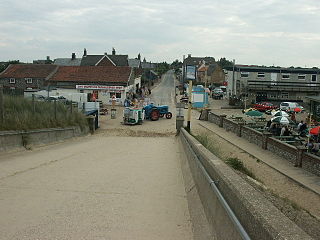
Sea Palling, also historically spelled Pawling and Pauling, is a village and civil parish covering 11.05 km2 (4.27 sq mi) in the English county of Norfolk. The village is 19.6 miles (31.5 km) south-east of Cromer, 19.6 miles (31.5 km) north-east of Norwich and 140 miles (230 km) north-east of London. The village lies 4 mi (6.4 km) east of the A149 between Kings Lynn and Great Yarmouth. The nearest railway station is at North Walsham for the Bittern Line, which runs between Sheringham, Cromer, and Norwich.
A rescue lifeboat is a boat rescue craft which is used to attend a vessel in distress, or its survivors, to rescue crew and passengers. It can be hand pulled, sail powered or powered by an engine. Lifeboats may be rigid, inflatable or rigid-inflatable combination-hulled vessels.

Mundesley Volunteer Inshore Lifeboat is a voluntary run lifeboat station located in the village of Mundesley in the English county of Norfolk. The station operates one lifeboat which is used for inshore work. The lifeboat service is a "Declared Facility"; this means that H.M. Coastguard regard it as being on a par with the RNLI. The lifeboat provides its service 24 hours a day, 365 days a year to windsurfers, fishing boats, swimmers and divers or anybody in distress within the Mundesley area. The service has also provided assistance to boats of various sizes which have required towing etc.

Atlantic College Lifeboat Station was an inshore lifeboat station based at the United World College of the Atlantic on the coast of South Wales, responsible for rescues in the challenging waters of the Bristol Channel.
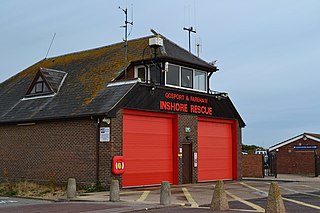
Gosport Lifeboat Station is a volunteer-operated independent lifeboat station charity located in the village of Alverstoke on the peninsula of Gosport in the English county of Hampshire. Owned and operated by Gosport and Fareham Inshore Rescue Service (GAFIRS), it operates free lifeboat services in the Solent from Portsmouth Harbour to Titchfield Haven, on the approaching shores of Southampton Water. GAFIRS is a charity registered in England and Wales (1159681).

Burnham Area Rescue Boat (BARB), also known as BARB Search & Rescue, is a voluntary independent search and rescue service, formed in 1992 in Burnham-on-Sea, Somerset that operates two rescue hovercraft and two inshore rescue boats in the Bridgwater Bay area. It is a registered charity.

Whitford's Volunteer Sea Rescue Group is a not for profit group based in Perth, Western Australia that provides emergency assistance, safety training, and search and rescue services for water users. It is similar in role to the different Auxiliary Coastguard and Coastwatch organisations in Australia.

Aldeburgh Lifeboat Station is an RNLI station located in the town of Aldeburgh in the English county of Suffolk.
A C-class lifeboat usually refers to the Zodiac Grand Raid Mark IVs lifeboats, powered by twin 40 hp outboard motors, manufactured by Zodiac Marine & Pool of France, and which were operated by the Royal National Lifeboat Institution.

Hayling Island Lifeboat Station is a Royal National Lifeboat Institution station located on Hayling Island in the English county of Hampshire, on the eastern side of the island at the entrance to Chichester Harbour where it joins the major shipping route of the Solent, and is opposite the village of West Wittering. This major shipping route is busy at all times of the year and there are estimated to be 10,000 boats in the Chichester area alone. The Hayling Island station provides cover for the area 24 hours a day, all year, by means of two inshore rigid inflatable lifeboats placed on this station.
Independent lifeboat services in Britain and Ireland began to be established around the coasts towards the end of the 18th century in response to the loss of life at sea. More recently, independent services have been set up in response to the increasing popularity of coastal and river sport and leisure activities.

Aberystwyth Lifeboat Station is a Royal National Lifeboat Institution (RNLI) lifeboat station in the coastal resort of Aberystwyth, Ceredigion, West Wales. It was established in 1861, but there has been a lifeboat serving the town since 1843.

Southport Offshore Rescue Trust (SORT) is the registered charity that runs the Southport Independent Lifeboat, a marine and land based search and rescue organisation on the Sefton coastline.

Criccieth Lifeboat Station is the base for Royal National Lifeboat Institution (RNLI) search and rescue operations at Criccieth in Gwynedd, Wales. It was opened in 1853 but was known as Portmadoc Lifeboat Station until 1892. It operates B-class and Arancia-class lifeboats.

